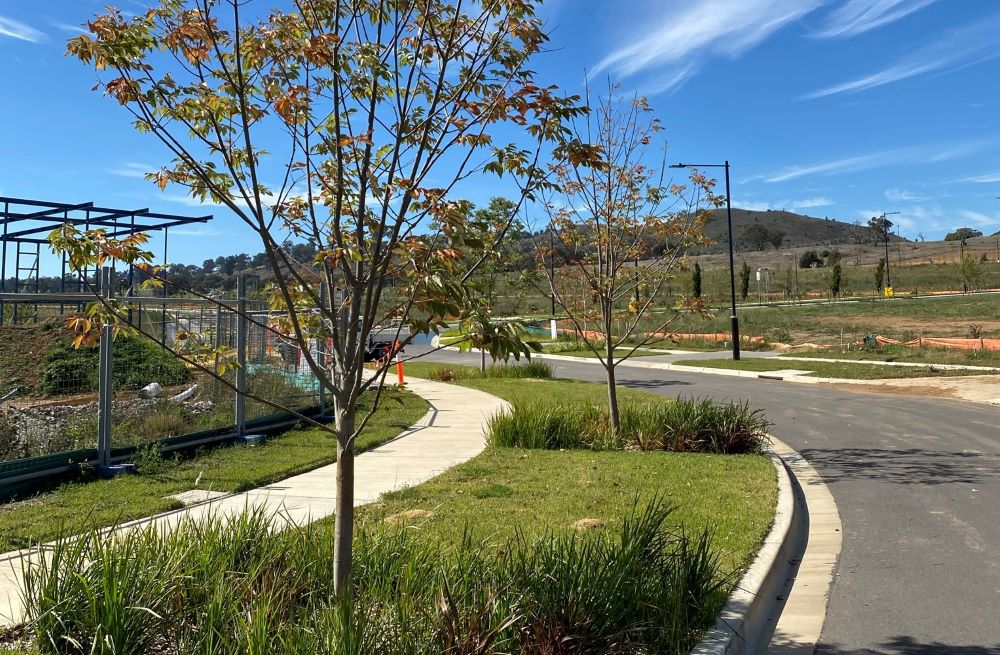Building resilience through living infrastructure
As we experience growing urbanisation and environmental challenges, cities around the world are re-evaluating their approach to urban planning and development.
Population projections estimate Canberra will need to cater for more than 600,000 people by 2050. Known for its abundant green spaces and sustainable living credentials, Australia’s capital has emerged as a beacon of innovation in urban design. The ACT Government's 2018 Living Infrastructure Plan and Urban Forest Act play pivotal roles, offering guidance on how to integrate nature within the urban fabric. These ambitions are directly supported by the Suburban Land Agency’s Resilient Communities approach to sustainable development.
Redesigning for resilience in our streetscapes
According to research done by the Victorian State Government, our roads and footpaths make up the largest area of public space in our cities. This provides an opportunity to improve environmental resilience through a range of solutions, especially by focusing on tree canopies.
Street trees are such an important part of Canberra's streetscapes. Providing homes for our local bird populations and shade to our footpaths and front gardens, these trees help grow Canberra's urban forest towards reaching our target of 30% tree canopy cover by 2045.
We partnered with the City and Environment Directorate (CED) to trial a number of ‘living infrastructure’ initiatives. Centred around the roads and verges in SLA’s Display Village in Whitlam, a core initiative aimed to get bigger trees into our new suburbs, faster.
Planting improvements
Getting bigger street trees into new suburbs helps fast-track the classic leafy feel of Canberra’s suburbs. But trees require significant water in their early years. This lead to the question as to whether a more passive use of water would allow them grow to their full potential in their early years through a more passive use of water.
A demonstration project in the Suburban Land Agency’s Display Village in Whitlam sought to understand the benefits of a range of new initiatives in how we can plant street trees.

Deeper pits to support better growth
Zelkova (Zelkova serrata) and Ash (Fraxinus pennyslvanica) trees were planted along Klaus Moje Street and St Leon Street in the SLA Display Village in Whitlam. The trees were planted in larger that usual 100L pots to fast-track the growth of Whitlam’s tree canopy.
A meta-analysis of 65 individual studies found that a doubling of the pot size increased biomass production by 43%. Biomass is the total weight of organisms within a certain volume area.
Improved soil conditions for healthier organic matter
To support the health and growth of these trees and the native plant mixes in the ‘tree pits’ surrounding the trees, higher quality soils were used in our experiment. These soils were made up of sandy soils and loams, tree planting mix and sand.
The higher quality soils were used to promote healthier root growth in the early stages of the trees' development. The soil also supports an increase in organic matter levels so that a positive feedback loop is created. Where roots supporting greater exchange of nutrients to microorganisms that then feed back into the root systems.
Twelve months after planting, we found that the zelkova and ash trees were growing taller and bushier than the control trees planted further along Klaus Moje Street. The control tress had been planted with the existing method, without special soils and kerb inlets to support their growth.
A passive use of storm water with kerb inlets
Typically, street trees need a lot of watering to support their growth in their early years. The demonstration project investigated how stormwater could irrigate the trees in a passive way through 3 different, specialised kerb inlets. This would reduce the need for active watering and reducing the resourcing needed to support tree growth.
The 3 kerb inlet types are all designed to capture and divert stormwater into the tree pits before it runs into the stormwater drains, which are further downhill on the streets.